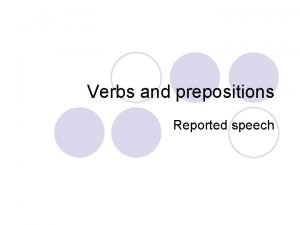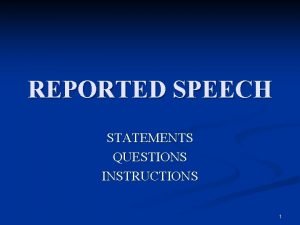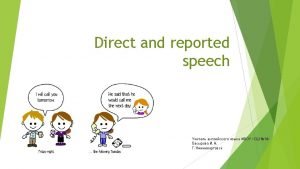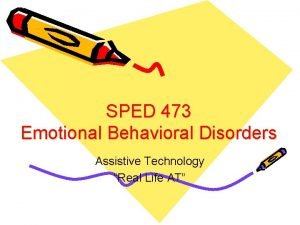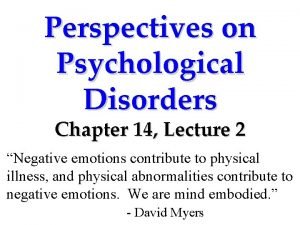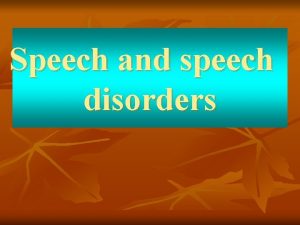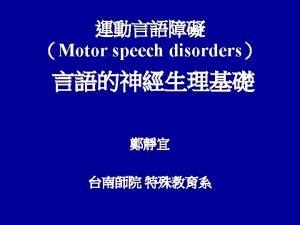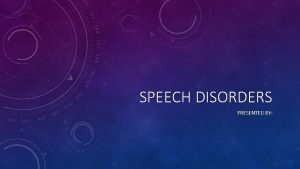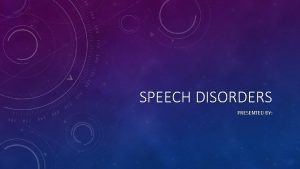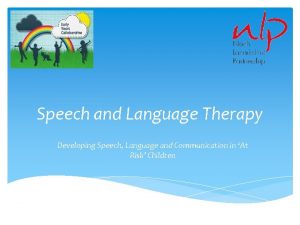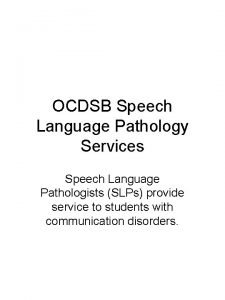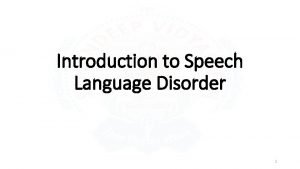speech and language disorders Speech Language disorders 1













- Slides: 13

speech and language disorders? Speech & Language disorders

1 - What are speech and language disorders? � Speech and language disorders are inabilities of individuals to understand and/or appropriately use the speech and language systems of society. � Such disorders may range from simple sound repetitions or occasional misarticulations to the complete absence of the ability to use speech and language for communication.

2 - What are some types of speech and language disorders? �Speech disorders may include: -Fluency disorder-an interruption in the flow or rhythm of speech characterized by hesitations, repetitions, or prolongations of nouns, syllables, words or phrases. -Articulation disorder-difficulties with the way sounds are formed and strung together usually characterized by substituting one sound for another (wabbit for rabbit), omitting a sound (han for hand) and distorting a sound (shlip for sip).

-Voice disorder-characterized by inappropriate pitch (too high, too low never changing or interrupted by breaks; quality (harsh, breathy or nasal); loudness, resonance, and duration. �Language disorders may include: - Aphasia-the loss of speech and language abilities generally resulting from stroke. - Delayed language-characterized by a marked slowness in the development of language skills necessary for expressing and understanding thoughts and ideas

3 - What are the causes of speech and language disorders? � Some of the causes of speech and language disorders are related to hearing loss, short memory span, and other neuromuscular disorders, severe head injuries, stroke, viral diseases, certain drugs, physical impairments such as cleft lip or palate, and inadequate speech and language models in the home environment. � The majority of voice disorders in children usually result from frequent vocal abuse associated with excessive throat clearing, coughing, or screaming.

- This abuse can cause inflammation of the larynx (vocal cords), or the formation of nodules and polyps, which are small growths, on the vocal cords. - Allergies, smoking, and the consumption of alcoholic beverages are other factors which may adversely affect the larynx (vocal cords) resulting in varying degrees of voice disorder. - In the following sections different types of aphasia will be discussed.

A- Broca’s aphasia � In this type of aphasia, speech is hesitant and not fluent, with many stops and deficient intonation. � Both speech and writing lack grammar. This kind of aphasia also is characterised by the incorrect use of grammatical morphemes (function words). Lexical morphemes are used but phonologically deformed.

B-Wernicke’s aphasia � A lesion in an area in the brain called Wernicke’s area causes this aphasia. Generally, language comprehension and expression are affected. The person may be quite fluent but his speech is meaningless. � The utterances are made of indefinite noun phrases sequences of actual or non-actual words. Comprehension and the ability to read and to repeat are damaged.

C- Anomic aphasia This type of aphasia is characterised by the difficulty to find words. Some patients block and may substitute the words they want to say. Others block even in writing.

D- Conduction aphasia While production and comprehension are whole, the ability is impaired. It is phonological. There are errors in the sequencing and selection of segments.

5 - Alexia and agraphia The patient can speak and understand correctly but unable to read and write (alexia and agraphia respectively). He / She can recognise individual letters but totally unable to read them in combination. There is another type of aphasia that is characterised by word deafness. The patient can speak, read, and write, but cannot understand spoken language.

From the above brief presentation of the types of aphasia , we can deduce that linguistics can provide the description, analysis and classification of language disorders. The latter are described in terms of the linguistic abilities of the patient- i. e. the four language skills: speaking, comprehension, reading and writing.

Thank You
 Looney tunes characters with speech impediments
Looney tunes characters with speech impediments Match the verbs and prepositions from
Match the verbs and prepositions from Pure speech
Pure speech Quoted and reported speech
Quoted and reported speech My sister is ready to go helen said
My sister is ready to go helen said Narration change exercise
Narration change exercise Reported speech exercises doc
Reported speech exercises doc Quoted speech vs reported speech
Quoted speech vs reported speech Health and social care unit 14
Health and social care unit 14 Bipolar and other related disorders
Bipolar and other related disorders Bipolar and other related disorders
Bipolar and other related disorders Assistive technology for behavior
Assistive technology for behavior Puberty and autism spectrum disorders
Puberty and autism spectrum disorders Axis 1 and axis 2 disorders
Axis 1 and axis 2 disorders

